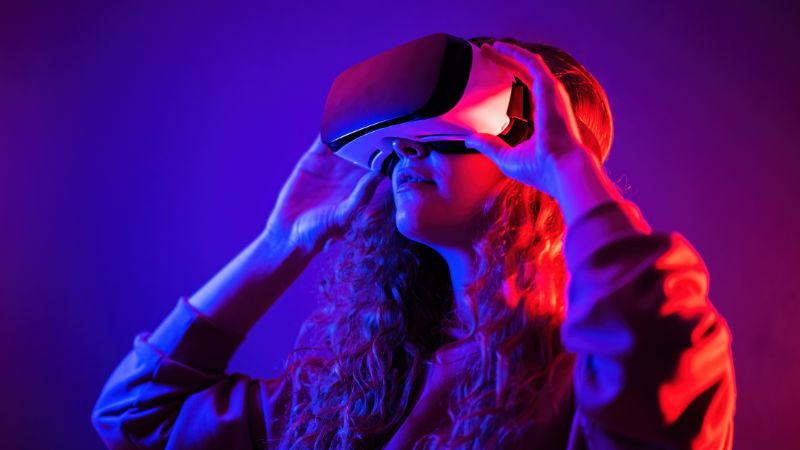Virtual Reality (VR) Therapy for PTSD: A Cutting-Edge Approach
Step into a world where healing and technology collide, offering hope and relief to those suffering from the invisible wounds of trauma. Virtual Reality (VR) Therapy is revolutionizing the way we approach Post-Traumatic Stress Disorder (PTSD), providing a cutting-edge solution that holds immense potential for transformation. Join us as we embark on a journey exploring the power of VR Therapy in combating PTSD, uncovering its remarkable benefits and shedding light on how you can find a skilled therapist to guide you through this innovative treatment method. Get ready to dive into an extraordinary realm where virtual reality meets healing, igniting new possibilities for recovery!
What is PTSD?
PTSD, or Post-Traumatic Stress Disorder, is a debilitating mental health condition that can occur after experiencing or witnessing a traumatic event. It goes beyond the normal response to stress and can have a profound impact on daily life. Individuals with PTSD often find themselves trapped in a cycle of intrusive memories, flashbacks, nightmares, and severe anxiety.
The symptoms of PTSD can vary from person to person but commonly include hyperarousal (being easily startled), avoidance of triggers associated with the trauma, negative thoughts and mood changes, and re-experiencing the traumatic event through distressing memories or dreams.
What sets PTSD apart from other mental health disorders is its link to specific traumatic events. Military combat, sexual assault, natural disasters – these are just some examples of experiences that can trigger PTSD. However, it’s important to remember that anyone who has experienced trauma could potentially develop this disorder.
Living with PTSD can be incredibly challenging as it affects all aspects of life – relationships may suffer due to emotional detachment or hypervigilance; work productivity may decline because concentration becomes difficult; even simple tasks like going out in public might induce overwhelming anxiety.
While traditional therapies such as cognitive-behavioral therapy (CBT) and medication have proven effective for many individuals with PTSD, there is growing excitement around an emerging treatment modality: Virtual Reality Therapy. This innovative approach harnesses the power of technology to create immersive environments where patients confront their traumas in a controlled setting – ultimately facilitating healing and recovery.
What is Virtual Reality (VR) Therapy?
Virtual Reality (VR) Therapy is a cutting-edge approach that harnesses the power of technology to help individuals suffering from Post-Traumatic Stress Disorder (PTSD). But what exactly is VR Therapy?
In simple terms, VR Therapy involves using virtual reality headsets and software to create lifelike and immersive experiences. These virtual environments are specifically designed to simulate situations or scenarios that trigger symptoms of PTSD in patients.
By exposing patients to these simulated experiences in a controlled and safe environment, therapists can guide them through the process of confronting their fears and anxieties. This allows patients to gradually desensitize themselves to traumatic memories or triggers, ultimately reducing the intensity of their emotional responses.
One of the key advantages of VR Therapy for PTSD is its ability to recreate real-world situations with high levels of detail and customization. Therapists can tailor each experience based on individual patient needs, ensuring maximum effectiveness.
Moreover, VR Therapy offers a level of control not found in traditional therapy methods. Therapists can adjust variables such as environmental factors or social interactions within the virtual environment, allowing for personalized treatment plans that address specific triggers unique to each patient’s trauma.
Another benefit is that VR Therapy provides a safe space for patients to confront their traumas without being exposed directly to potentially triggering situations in real life. This controlled exposure enables individuals with PTSD to build resilience and develop coping mechanisms while feeling supported by their therapist throughout the process.
Furthermore, studies have shown promising results when it comes to using VR Therapy for treating PTSD. Research suggests that this innovative approach can lead to significant reductions in symptoms such as anxiety, avoidance behaviors, nightmares, and hyperarousal.
However, it’s important also highlight potential risks associated with this therapy method. Some individuals may find certain virtual simulations too overwhelming or distressing, which could exacerbate symptoms temporarily during treatment sessions. It’s crucial for therapists utilizing this technique closely monitor patients’ reactions and make adjustments accordingly.
If you’re interested in exploring VR Therapy for PTSD, it’s essential to find a therapist who is experienced and knowledgeable in the field. This will ensure that you or your loved one receive the highest level of care and optimal outcomes from this new and exciting treatment modality.
How does VR Therapy work for PTSD?
Virtual Reality (VR) Therapy is a cutting-edge approach that holds immense potential in helping individuals with Post-Traumatic Stress Disorder (PTSD). But how exactly does VR Therapy work for PTSD?
The process begins by immersing the individual in a virtual environment, which simulates scenarios related to their traumatic experiences. This can include combat situations, natural disasters, or any other triggers specific to the person’s trauma. By creating this realistic and controlled environment, VR Therapy allows individuals to confront and engage with their fears in a safe space.
During these virtual simulations, therapists guide patients through various techniques such as exposure therapy and cognitive behavioral therapy. The goal is to help patients gradually desensitize themselves to the traumatic memories or triggers that cause distress. With repeated exposure and practice within the virtual world, individuals can learn coping mechanisms and develop strategies to manage their symptoms.
One of the key benefits of VR Therapy for PTSD is its ability to provide a sense of presence. Unlike traditional forms of therapy where patients rely on imagination or memory recall alone, VR creates an immersive experience that closely mirrors real-life situations. This heightened sense of realism helps elicit emotional responses similar to those experienced during actual events.
Moreover, VR Therapy offers flexibility in tailoring treatment plans based on individual needs. Therapists can adjust parameters within the virtual environment like intensity levels or pacing according to each patient’s progress and comfort level. This personalized approach ensures that treatment aligns with each person’s unique circumstances.
Additionally, VR Therapy provides opportunities for patients to practice skills they’ve learned outside of sessions. They can use at-home Virtual Reality headsets for ongoing self-guided exposure exercises under professional guidance remotely connected via telehealth platforms.
It is important to note that while there are significant benefits associated with VR Therapy for PTSD treatment, it may not be suitable for everyone. It requires careful evaluation by trained professionals who specialize in both virtual reality technology and trauma-focused therapies.
VR Therapy offers a groundbreaking avenue for treating PTSD. By creating immersive virtual environments that simulate traumatic experiences, it allows individuals to confront their fears and learn coping mechanisms in a safe and controlled setting. With personalized treatment plans and ongoing remote support, VR Therapy is well-positioned to become an invaluable resource for those living with PTSD.
What are the benefits of VR Therapy for PTSD?
Virtual Reality (VR) therapy is a cutting-edge approach that has shown significant promise in treating post-traumatic stress disorder (PTSD). By immersing individuals in realistic virtual environments, this innovative therapy allows therapists to recreate the traumatic events and help patients process their emotions and reactions in a safe and controlled setting.
One of the key benefits of VR therapy for PTSD is its ability to provide exposure therapy. Through gradual exposure to the traumatic memories, individuals can confront their fears without being overwhelmed by them. This desensitization process helps to reduce anxiety and fear responses associated with specific triggers or situations related to their trauma.
Furthermore, VR therapy allows therapists to tailor treatment specifically to each individual’s needs. They can modify virtual scenarios based on the patient’s experiences, making it more personalized and effective. The immersive nature of VR also enhances engagement during sessions, as patients are actively participating rather than simply talking about their trauma.
Another advantage of using VR technology is that it creates a sense of presence and realism that traditional therapies cannot replicate. This heightened level of immersion helps patients feel as if they are truly present in the virtual world, which promotes greater emotional engagement with the therapeutic process.
In addition, VR therapy offers a safe space for individuals to practice coping strategies and develop new skills in managing their PTSD symptoms. Patients can experiment with different techniques such as relaxation exercises or cognitive restructuring while experiencing simulated stressful situations within the virtual environment.
Moreover, research has shown promising results regarding the long-term effectiveness of VR therapy for PTSD. Studies have demonstrated reductions in symptom severity and improved quality-of-life outcomes among participants who underwent this type of treatment compared to those receiving traditional therapies alone.
Virtual Reality Therapy provides unique benefits for individuals suffering from PTSD by offering tailored exposure-based interventions within an immersive environment. These advantages include personalized treatment options, increased engagement levels during sessions due to enhanced realism, opportunities for practicing coping strategies within a safe space, and long-term therapeutic efficacy. As the field of VR therapy continues to grow, these benefits are likely to become even more pronounced.
Are there any risks associated with VR Therapy for PTSD?
When it comes to any form of therapy, including virtual reality (VR) therapy for post-traumatic stress disorder (PTSD), it’s important to consider potential risks. While VR therapy has shown promising results in treating PTSD, there are a few factors that need careful attention.
One possible risk is the potential for triggering intense emotional reactions during the VR sessions. The immersive nature of VR can make the experience feel incredibly real, which means that individuals undergoing therapy may be exposed to distressing and traumatic situations. This can lead to temporary feelings of anxiety or distress during or after the session.
Additionally, some individuals may experience physical discomfort while wearing the VR headset, such as headaches or dizziness. These side effects are usually temporary and tend to diminish over time as users become more accustomed to using the technology.
Another consideration is that not all therapists have extensive training in utilizing VR technology specifically for PTSD treatment. It’s essential to find a qualified therapist who specializes in this type of therapy and understands how to navigate potential risks effectively.
It’s worth noting that research on the long-term effects of VR therapy for PTSD is still ongoing, so it’s crucial to approach this treatment modality with caution and regularly communicate with your therapist about any concerns or adverse effects you may be experiencing.
While there are risks associated with VR therapy for PTSD, they can typically be minimized through proper screening, monitoring by a trained professional, and open communication between the therapist and individual undergoing treatment. With these precautions in place, many people have found significant relief from their symptoms through this cutting-edge therapeutic approach.
How to find a VR Therapist
Finding a VR therapist who specializes in PTSD can be an important step towards healing and recovery. Here are some tips on how to find the right professional for you:
Research and referrals:
Start by doing your own research online or ask for recommendations from friends, family, or healthcare professionals. Look for therapists who have experience with virtual reality therapy specifically for PTSD.
Check credentials:
Ensure that the VR therapist you choose is licensed and certified in their field. This will ensure they meet certain standards of professionalism and expertise.
Seek specialized clinics or centers:
Look for clinics or treatment centers that specialize in trauma-related disorders such as PTSD. These facilities may offer specific programs tailored to help individuals using virtual reality therapy techniques.
Consultations:
Schedule consultations with potential VR therapists to discuss your needs, preferences, and treatment goals. This will give you an opportunity to see if there is a good fit between you and the therapist.
Consider accessibility:
If possible, choose a VR therapist who is easily accessible to you either through location or teletherapy options.
Remember, finding the right VR therapist takes time and patience. Trust your instincts when making this important decision as it can greatly impact your therapy journey towards healing from PTSD.
Conclusion
Virtual Reality (VR) therapy is emerging as a cutting-edge approach for treating post-traumatic stress disorder (PTSD). By immersing individuals in realistic simulations, VR therapy allows them to confront and process traumatic experiences in a safe and controlled environment. The use of VR technology has shown promising results in reducing PTSD symptoms and improving overall mental health.
The benefits of VR therapy for PTSD are numerous. It provides a sense of presence and immersion that traditional therapies cannot replicate, allowing patients to experience their trauma in a more vivid way. This helps them gain insight into their emotions, thoughts, and reactions related to the traumatic event. Additionally, virtual reality can be customized to each individual’s needs, making it highly adaptable for different types of trauma.
One major advantage of using VR therapy is its ability to provide exposure therapy without putting individuals at risk or triggering overwhelming anxiety. Therapists can gradually expose patients to triggers associated with their trauma while maintaining control over the intensity level. This gradual desensitization helps reduce fear responses over time and empowers individuals to regain control over their lives.
However, it is important to note that like any form of therapy, there may be risks associated with VR treatment for PTSD. Some individuals may find the experience too intense or become emotionally overwhelmed during sessions. It is crucial that therapists closely monitor patients throughout the process and adjust treatment accordingly.
Finding a qualified VR therapist experienced in treating PTSD is essential for successful outcomes. Look for professionals who have expertise in both virtual reality technology and trauma-focused therapy techniques. They should also have proper certifications from reputable organizations.
In conclusion, Virtual Reality Therapy offers great potential as an innovative approach towards alleviating the symptoms of Post-Traumatic Stress Disorder(PTSD). As research continues to expand on this topic, the future holds exciting possibilities for utilizing Virtual Reality Therapy as an effective tool against one of society’s most debilitating mental health conditions.


